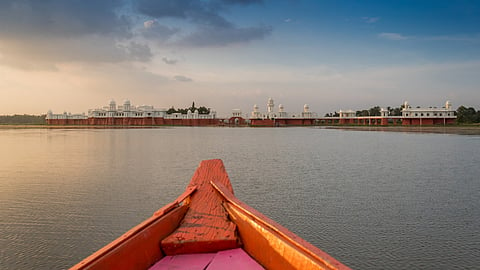
- Destinations
- Experiences
- Stay
- What's new
- Editor’s Picks
- Responsible Tourism
- CampaignsCampaigns
- Subscribe

Udaipur, Tripura&rsquos historic capital, is situated on the banks of the Gomati river. About 53 km from Agartala, this small town can be easily accessed via road from the capital city.
Referred to as the &lsquoLake City&rsquo, the town serves as the headquarters of the Gomati District. Udaipur was the Manikya kings' capital until Maharaja Krishna Chandra Manikya Bahadur moved the capital to Agartala.
Formerly known as Rangamati, Udaipur is dotted with many beautiful lakes and ancient temples. The Tripura Sundari Temple is the holiest shrine for the people of this state, while some of the popular lakes, which are frequen- ted by tourists, include Kalyan Sagar, Mahadeb Dighi, Jagannath Dighi, Amar Sagar and Dhani Sagar.
The city is located at an elevation of 790m, with the Gomati river flowing through its middle. One can visit the tourist spots located within the city by autorickshaws, while taxis and buses are easily available for travelling to sites on the outskirts
Tripura sundari Temple
Also known as Matabari (Mother Goddess), the Tirupati Sundari Temple is amongst the most revered shrines in India, as one of the 51 Shaktipeethas of the Hindu religion. The temple is constructed by Maharaja Dhanya Manikya Debbarma in 1501 and is dedicated to Goddess Kali, who is worshipped as Soroshi.
On the eastern side of the temple lies the vast Kalyan Sagar Lake, which is home to tortoises. Devotees offer prayers to the tortoises and feed them puffed rice and biscuits. The temple is referred to as Koorma Peeth, koorma meaning tortoise.
A fair at this temple every year during Diwali attracts over two lakh devotees.
Bhuvaneswari Temple
Situated on the northern banks of the Gomati river, adjacent to the ruins of the 17th-century Old Palace, this temple has been immortalised in two of Rabindranath Tagore&rsquos plays, Rajarshi and Bisharjan. It is a rare example of temple architecture built between 1667 and 1676 by Maharaja Gobinda Manikya. Perched on a 3-ft-high elevated platform, it has stupas adorned with floral motifs.
Tepania Eco Park
Barely 5km away from Udaipur, on the Udaipur-Agartala Road, lies the beautiful Tepania Eco Park. The park's highlight is a beautiful orchidarium, which has over 200 species of orchids, and a Cactus House, which has nearly 200 kinds of cacti. The park is a hotspot for picnickers. One can also enjoy an overnight halt in the treehouse inside the park.
Devtamura Rock Carving
 After reaching Rangamati, a scenic boat ride takes you to Devtamura, a hill range between Udaipur and Amarpur. Meaning the &lsquopeak of gods&rsquo, Devtamura is covered with thick jungles. While walking around, one will come across rock-cut sculptures dating back to the 15th and 16th centuries CE. Sculptures of Lord Shiva, Vishnu, Kartikeya and Goddess Durga stand beautifully amidst lush vegetation along River Gomati.
There are 37 rock-cut images on the hill. What leaves you amazed is the dexterity with which the artists carved these sculptures on the rocky surface of the Devtamura hills. The purpose of these carvings is unknown. This place is also known as the Chabimura. The Chabimura Festival is celebrated annually in mid-January, and occurs at a particular spot on the hilltop, where a waterfall emerges. The tribals bathe in the river during this festival. One can also stay the night at hotels located on the hills.
Pilak
The fascinating archaeological site of Pilak lies in Belonia sub-division and is 100km south of Agartala. One can take a bus to Julaibari in Belonia, and then an autorickshaw for the remaining 5-km stretch.
Spread over an area of 3 sq km, Pilak is home to a treasure trove of Hindu and Buddhist sculptures, dating from the 8th to 12th centuries CE. The site is also a testimony to the peaceful coexistence of the two religions, with images and engravings representing Hindu gods&ndashShiva, Surya, Baishnabi&ndashand Buddhist deities from the Hinayana, Mahayana and Bajrayana sects.
